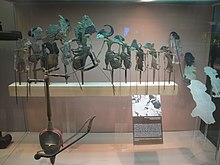User:Coryannyyz/sandbox
This is the sandbox page where I will write edits for American Museum of Natural History.
Margaret Mead Hall of Pacific Peoples (this section is done and posted)[edit]

The Hall of Pacific Peoples is on the southwestern corner of the third floor, accessed through the Hall of Plains Indians.[1] The cultural anthropologist Margaret Mead had founded the Hall of Pacific Peoples in 1971.[2] From the time Mead began curatorial work on the hall in 1945, she conceived an exhibit environment that would emulate sights and sounds from the Pacific regions on display.[3] After Mead's death in 1978, the hall reopened in December 1984 as the Margaret Mead Hall of Pacific Peoples.[4][5] The new hall, designed by Eugene Burgmann, maintained the blue-themed ocean and sky ambiance of the original hall.[3] The hall was once again closed in 1997 and reopened in 2001 with an updated design that retained the geocultural "alcoves" first installed with the 1984 remodel.[6]

The Margaret Mead Hall of Pacific Peoples contains artifacts from New Zealand, Australia, Indonesia, the Philippines, Micronesia, Melanesia and other Pacific islands.[7][8][6] Mead had collected 250 of the 1,500 items in the hall. Some of these were probably selected from the 3,284 items she collected for the American Museum of Natural History during fieldwork in New Guinea and other Pacific island locations, 1928-1939.[9] Others, such as the theatrical set from a puppet play in Bali, were chosen from among the approximately 600 items that Mead and her anthropologist husband Gregory Bateson had sent to the American Museum of Natural History while they were conducting fieldwork in Bali, 1936-1938.[6] The exhibits in the Margaret Mead Hall of Pacific Peoples also include a fiberglass cast of an Easter Island moai statue and capes made of honeycreeper feathers.[8]
Hall of Plains Indians[edit]

The Hall of Plains Indians is on the south side of the third floor, near the western end of the museum.[10] This hall opened in February 1967.[11][12] The primary focus of this hall is the North American Great Plains peoples as they were at the middle of the 19th century, including depictions of Blackfeet (see also: Blackfoot Confederacy), Hidatsa, and Dakota cultures. Of particular interest is a Folsom point discovered in 1926 New Mexico, providing evidence of early American colonization of the Americas. [13]
Hall of Eastern Woodlands Indians[edit]
The Hall of Eastern Woodlands Indians is next to the Hall of Plains Indians, on the south side of the third floor.[14] This hall opened in May 1966.[15] It details the lives and technology of traditional Native American peoples in the woodland environments of eastern North America. These include Cree, Mohegan, Ojibwe, and Iroquois cultures. The exhibit features examples of indigenous basketry, pottery, farming techniques, food preparation, metal jewelry, musical instruments, and textiles. Other highlights include a model of a Menominee birchbark canoe and various traditional lodgings such as an Ojibwa domed wigwam, an Iroquois longhouse, a Creek council house, and other eastern woodland dwelling styles.[16]
- ^ "Interactive Map". American Museum of Natural History. Retrieved 2022-06-13.
- ^ "Margaret Mead Hall For American Museum". The New York Times. 1984-11-26. ISSN 0362-4331. Retrieved 2022-06-06.
- ^ a b Losche, Diane (2006). "The Fate of the Senses in Ethnographic Modernity: The Margaret Mead Hall of Pacific Peoples at the American Museum of Natural History". In Edwards, Elizabeth; Gosden, Chris; Phillips, Ruth (eds.). Sensible Objects: Colonialism, Museums and Material Culture. New York: Berg. pp. 223–244. ISBN 978 1 84520 323 8.
- ^ Unger, Michael (1984-12-18). "Remembering Mead". Newsday. p. 135. Retrieved 2022-06-06.
- ^ "Margaret Mead Hall At American Museum". The New York Times. 1984-12-14. ISSN 0362-4331. Retrieved 2022-06-06.
- ^ a b c Mohan, Urmila (2021). "The Indonesian Alcove at the American Museum of Natural History: Art, Culture Areas, and the Mead-Bateson Bali Project". Museum Anthropology. 44 (1–2): 11–23. doi:10.1111/muan.12233.
- ^ "Hall of Pacific Peoples". American Museum of Natural History. August 2, 2018. Retrieved June 6, 2022.
- ^ a b "At New Mead Hall, a Bygone World". The New York Times. 1984-12-21. ISSN 0362-4331. Retrieved 2022-06-06.
- ^ Jacknis, Ira (2015). "'America Is Our Field': Anthropological Regionalism at the American Museum of Natural History, 1895–1945". Museum & Society. 13 (1): 52–71.
- ^ "Interactive Map". American Museum of Natural History. Retrieved 2022-06-13.
- ^ Teltsch, Kathleen (1967-02-21). "Plains Indians Ride Again in Museum Here; Natural History Hall Shows Them at War and Play". The New York Times. ISSN 0362-4331. Retrieved 2022-06-15.
- ^ "Museum Opens Hall on Plains Indians". The Record. 1967-02-22. p. 9. Retrieved 2022-06-15.
- ^ "Hall of Plains Indians: Native American Peoples". American Museum of Natural History. 2018-08-02. Retrieved 2022-06-15.
- ^ "Interactive Map". American Museum of Natural History. Retrieved 2022-06-13.
- ^ "New Indian Hall Opens At American Museum". The New York Times. 1966-05-24. ISSN 0362-4331. Retrieved 2022-06-15.
- ^ "Hall of Eastern Woodlands Native Americans | AMNH". Archived from the original on November 27, 2021. Retrieved November 27, 2021.
